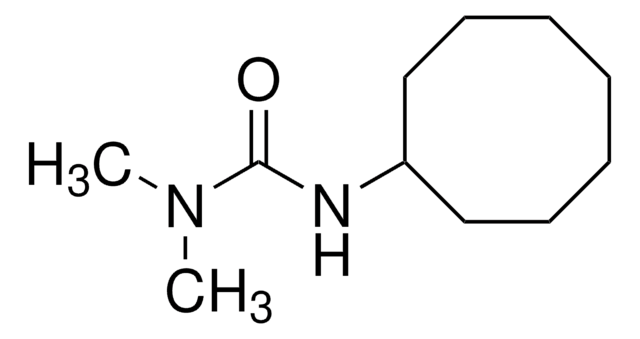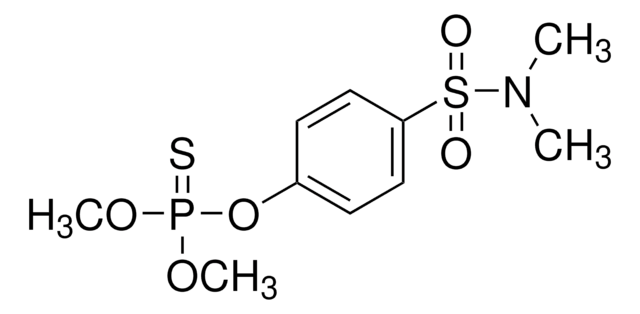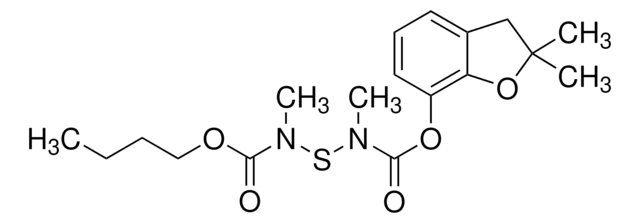52131
2-C-Methyl-D-erythritol 4-phosphate lithium salt
≥98% (TLC)
Sinónimos:
MEP
Iniciar sesiónpara Ver la Fijación de precios por contrato y de la organización
About This Item
Fórmula empírica (notación de Hill):
C5H11O7P · xLi+
Número de CAS:
Peso molecular:
214.11 (free acid basis)
Código UNSPSC:
12352106
ID de la sustancia en PubChem:
NACRES:
NA.25
Productos recomendados
Nivel de calidad
Ensayo
≥98% (TLC)
temp. de almacenamiento
−20°C
cadena SMILES
O=P(O)(O)OC[C@H](O)[C@@](O)(C)CO.C
InChI
1S/C5H13O7P/c1-5(8,3-6)4(7)2-12-13(9,10)11/h4,6-8H,2-3H2,1H3,(H2,9,10,11)/t4-,5+/m1/s1
Clave InChI
XMWHRVNVKDKBRG-UHNVWZDZSA-N
Aplicación
2-C-Methyl-D-erythritol 4-phosphate (MEP), the product of reductoisomerase IspC and first committed MEP pathway intermediate, is used to study the non-mevalonate MEP pathway for the biosynthesis of isoprenoids. MEP is used as a precursor for the synthesis of 4-diphosphocytidyl-2-C-methyl D-erythritol (CDP-ME), a key intermediate of the non-mevalonate pathway.
Acciones bioquímicas o fisiológicas
Metabolite intermediate specific to the non-mevalonate MEP pathway, generally found in prokaryotes, as precursor to isoprenoids as well as non-isoprenoids like vitamins. As this pathway is not present in humans, it is of interest for the development of bacterium-specific drugs in the search for treatments of infectious diseases.
Envase
Bottomless glass bottle. Contents are inside inserted fused cone.
Código de clase de almacenamiento
11 - Combustible Solids
Clase de riesgo para el agua (WGK)
WGK 3
Punto de inflamabilidad (°F)
Not applicable
Punto de inflamabilidad (°C)
Not applicable
Elija entre una de las versiones más recientes:
¿Ya tiene este producto?
Encuentre la documentación para los productos que ha comprado recientemente en la Biblioteca de documentos.
Tomohisa Kuzuyama et al.
Proceedings of the Japan Academy. Series B, Physical and biological sciences, 88(3), 41-52 (2012-03-28)
Isoprenoids are a diverse group of molecules found in all organisms, where they perform such important biological functions as hormone signaling (e.g., steroids) in mammals, antioxidation (e.g., carotenoids) in plants, electron transport (e.g., ubiquinone), and cell wall biosynthesis intermediates in
Sinéad Heuston et al.
Microbiology (Reading, England), 158(Pt 6), 1389-1401 (2012-04-03)
Isoprenoid biosynthesis is essential for cell survival. Over 35 000 isoprenoid molecules have been identified to date in the three domains of life (bacteria, archaea and eukaryotes), and these molecules are involved in a wide variety of vital biological functions. Isoprenoids
J Kipchirchir Bitok et al.
ACS chemical biology, 7(10), 1702-1710 (2012-07-31)
There is significant progress toward understanding catalysis throughout the essential MEP pathway to isoprenoids in human pathogens; however, little is known about pathway regulation. The present study begins by testing the hypothesis that isoprenoid biosynthesis is regulated via feedback inhibition
Hyungjin Eoh et al.
Tuberculosis (Edinburgh, Scotland), 89(1), 1-11 (2008-09-17)
Tuberculosis (TB) is still a major public health problem, compounded by the human immunodeficiency virus (HIV)-TB co-infection and recent emergence of multidrug-resistant (MDR) and extensively drug resistant (XDR)-TB. Novel anti-TB drugs are urgently required. In this context, the 2C-methyl-d-erythritol 4-phosphate
Andréa Hemmerlin et al.
Progress in lipid research, 51(2), 95-148 (2011-12-27)
When compared to other organisms, plants are atypical with respect to isoprenoid biosynthesis: they utilize two distinct and separately compartmentalized pathways to build up isoprene units. The co-existence of these pathways in the cytosol and in plastids might permit the
Nuestro equipo de científicos tiene experiencia en todas las áreas de investigación: Ciencias de la vida, Ciencia de los materiales, Síntesis química, Cromatografía, Analítica y muchas otras.
Póngase en contacto con el Servicio técnico







